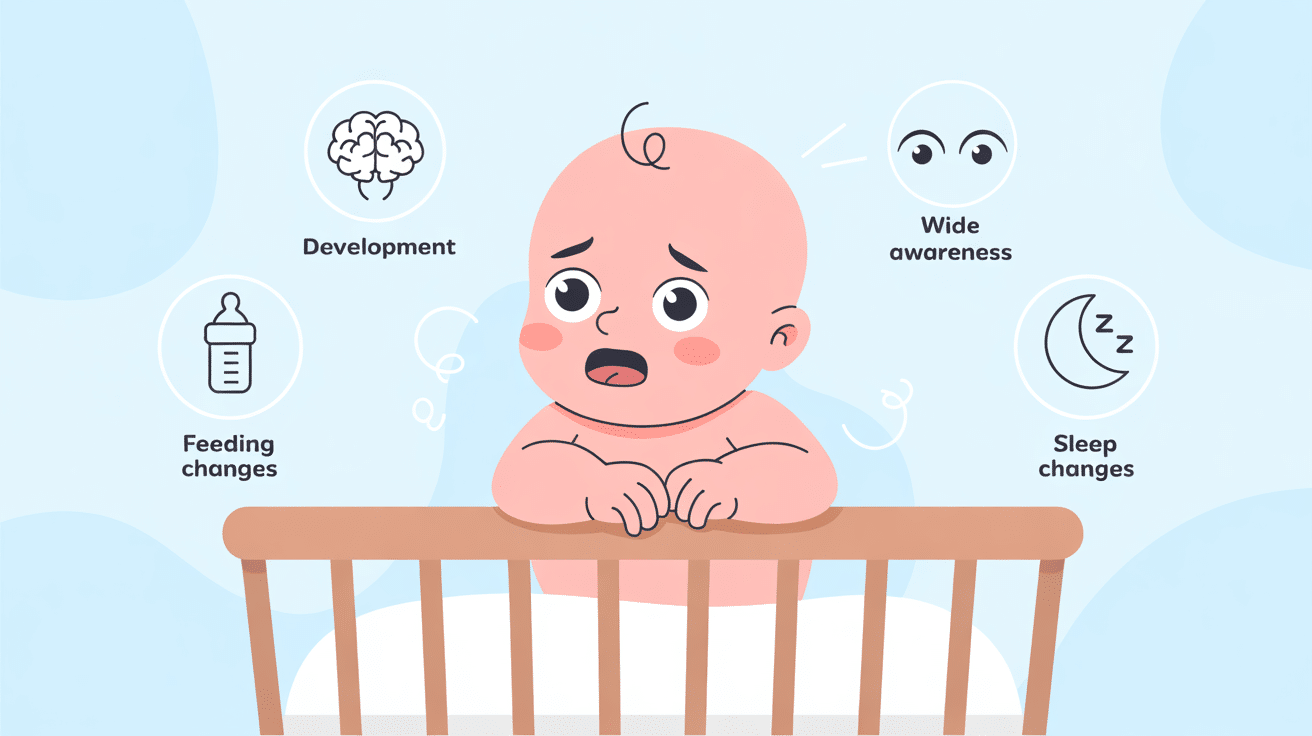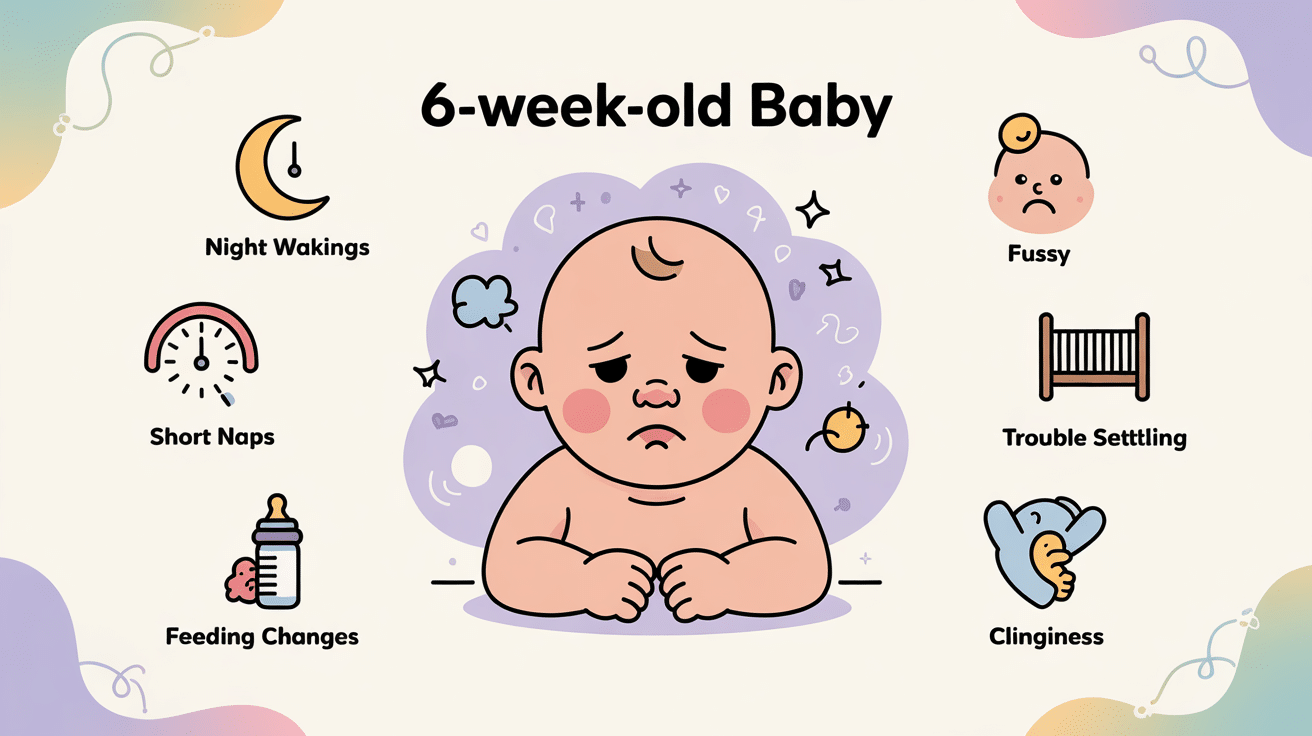
Is your once-peaceful newborn suddenly fighting sleep like it’s their full-time job? You’re not alone—you’ve hit the infamous 6-week sleep regression!
This mysterious phenomenon strikes just when you thought you were getting the hang of parenthood, turning your little sleep angel into a wide-eyed night owl.
Sleep regression happens when developmental leaps collide with your baby’s immature sleep cycles, creating the perfect storm of sleepless nights.
At six weeks, your baby’s brain is experiencing an explosion of growth—they’re noticing more, feeling more, and unfortunately, waking more.
Before you resign yourself to a lifetime of exhaustion, here’s the good news: This challenging phase is both completely normal and mercifully temporary.
Understanding what’s happening behind those adorable sleepless eyes is your first step toward reclaiming precious sleep for everyone in your household.
What Is the 6-Week Sleep Regression?
The 6-week sleep regression refers to a period when your previously settling baby suddenly experiences disrupted sleep patterns.
While technically not a true regression (as newborns haven’t established stable sleep patterns to regress from), this phase coincides with significant developmental changes.
At 6 weeks, babies begin transitioning from newborn sleep cycles to more mature patterns, developing their circadian rhythm and experiencing more alert periods.
Their brains are processing more environmental stimuli, making it harder to filter out distractions during sleep.
What parents experience as “regression” is actually your baby’s evolving neurological development and increasing awareness of their surroundings – a sign of healthy growth despite the temporary sleep challenges.
Why the 6-Week Sleep Regression Happens?

The 6-week sleep regression coincides with several critical developmental changes in your baby’s life. Around this age, babies experience their first major growth spurt, requiring more calories and potentially disrupting established feeding and sleeping patterns.
Neurologically, your baby’s brain is undergoing remarkable development, forming new neural connections that affect sleep cycles and wake patterns.
Sleep architecture begins shifting from the newborn state toward more mature sleep stages, with increasing periods of light sleep where babies are more easily disturbed.
Additionally, your baby’s sensory awareness is expanding dramatically – they’re beginning to notice lights, sounds, and movements in ways they couldn’t before. This newfound environmental sensitivity can make it challenging for them to filter out stimuli during sleep time.
These simultaneous developmental leaps represent healthy progression, though they temporarily impact sleep quality and duration.
Signs and Symptoms of the 6-Week Sleep Regression

If you’re wondering whether your baby has hit the 6-week sleep regression, there are several telltale signs to watch for.
This challenging phase presents itself differently in each baby, but certain patterns are common across most infants experiencing this developmental leap.
1. Increased Fussiness and Difficulty Settling
As your baby approaches one year, you may notice increased fussiness and trouble settling, especially at bedtime. Calming routines that once worked might lose their effect, leading to crying or resistance.
Signs of overtiredness—rubbing eyes, yawning, or a glazed look—can worsen the struggle to fall asleep peacefully. This shift is often due to developmental changes, growing independence, and heightened awareness of surroundings.
2. More Frequent Night Wakings
One of the most challenging parts of the 6-week sleep regression is the sudden increase in nighttime wake-ups. A baby who once slept for 3–4 hour stretches may now wake every 1–2 hours, often struggling to settle back to sleep.
These frequent disruptions can leave both the baby and the parents overtired and frustrated. This shift is usually temporary, triggered by rapid growth and neurological development, but it can feel overwhelming in the moment.
3. Shorter Naps or Nap Resistance
Daytime sleep often suffers during the 6-week regression. Many babies begin taking short naps of just 30–40 minutes, waking after a single sleep cycle instead of transitioning into the next.
Nap resistance is also common—your baby may fuss, cry, or refuse to settle even when clearly tired. This disruption is often linked to developmental changes affecting sleep cycles and self-soothing abilities.
4. Changes in Feeding Patterns
Sleep and feeding are closely connected at this age, especially during the 6-week regression. Many babies begin cluster feeding—nursing more frequently, particularly in the evening—as they seek extra comfort and calories.
At the same time, increased awareness can cause distracted feeding, resulting in shorter, less effective sessions and more frequent hunger-related wake-ups. These changes are normal and often temporary but can add to sleep challenges during this phase.
5. Increased Clinginess During the Day
Many parents notice their babies becoming more clingy during sleep regressions. Early signs of separation anxiety can surface, making your baby crave more holding and closeness, even at this young age.
While not all babies will show every sign, changes in behavior that differ from their usual routine during this developmental stage are common. Paying attention to these shifts can help you respond with patience and reassurance.
How Long Does the 6-Week Sleep Regression Last?

The 6-week sleep regression typically lasts between 1-2 weeks for most babies, though this timeframe can vary considerably.
Some lucky parents might notice their baby moving through this phase in just a few days, while others may experience disrupted sleep patterns for up to three weeks.
Several factors influence the duration, including your baby’s unique temperament, their overall health, and how consistently you respond to the regression.
Environmental factors like household routines, noise levels, and sleep environment can also impact how quickly your baby adjusts. Generally, you can expect sleep to improve as your baby integrates their new developmental skills gradually.
Most parents notice a natural resolution by 8 weeks of age, when babies often experience a temporary plateau in development before the next growth spurt around 3 months.
How to Survive the 6-Week Sleep Regression

The 6-week sleep regression can test even the most patient parents. While you can’t skip this developmental phase, there are effective strategies to help both you and your baby weather this challenging period with minimal stress.
1. Creating a Consistent Bedtime Routine
Consistency is key during sleep regressions, even if it doesn’t seem to work right away. A simple, predictable bedtime routine—like a warm bath, gentle massage, feeding, and a lullaby—can help build sleep associations.
Stick to a consistent start time and choose calming, low-stimulation activities to support your baby’s developing internal clock and promote restful sleep.
2. Optimizing the Sleep Environment
Your baby’s sleep environment is essential for quality rest, especially during regressions. Keep the room temperature between 68–72°F (20–22°C) to avoid disruptions from overheating or feeling too cold.
Darkness also plays a key role—blackout curtains help promote melatonin production and reinforce sleep cues. Adding white noise can be beneficial too, as it masks household sounds and mimics the comforting consistency of the womb, helping your baby settle and stay asleep.
3. Adjusting Feeding Schedules If Necessary
Hunger is a common cause of frequent wake-ups during the 6-week sleep regression. Offering cluster feeds in the evening can help fill your baby up before their longest sleep stretch.
Some parents also try a dream feed around 10–11 PM to reduce night-wakings. Make sure feeds are efficient—if breastfeeding, allow your baby to fully empty one breast before switching to the other to ensure they’re getting enough.
4. Using Soothing Techniques Effectively
Different babies respond to different soothing methods, so it’s important to experiment and find what works best for your little one. Dr. Harvey Karp’s 5 S’s—Swaddle, Side/Stomach position (while awake and supervised), Shush, Swing, and Suck—can be especially helpful for calming fussy babies.
Babywearing is another effective technique, offering comfort and closeness while allowing you to stay mobile. Some babies also respond well to gentle motion, such as being rocked in a swing, bounced in a bouncer, or taken for a stroller walk during difficult periods.
5. Managing Your Sleep and Well-Being
One of the most overlooked yet essential parts of handling sleep regression is taking care of yourself. Sharing responsibilities with a partner or family member—even to get a 3–4 hour stretch of uninterrupted sleep—can make a big difference.
Accept help when it’s offered, whether it’s someone holding the baby so you can shower or rest. Lower your expectations around chores and meals—prioritize only what’s necessary and use shortcuts when needed. Most importantly, practice mindfulness.
Sleep Products That May Help During the 6-Week Regression

During the challenging 6-week sleep regression, certain products can provide valuable assistance in helping your baby—and by extension, you—get more restful sleep.
While no product offers a guaranteed solution, these tools may help create an environment conducive to better sleep during this developmental transition.
1. Swaddles and Sleep Sacks
Swaddling remains one of the most effective techniques for helping young babies sleep during the 6-week regression period. It mimics the snug, secure feeling of the womb and can reduce startle reflexes that often wake babies during light sleep.
2. Velcro or Zip Swaddles
Velcro or zip swaddles provide the security of a traditional swaddle with added convenience. Their quick, hassle-free design makes midnight diaper changes smoother and less disruptive, helping both you and your baby return to sleep more easily.
3. White Noise Machines
White noise machines can be a helpful tool during sleep regressions. They mask household noises and mimic the familiar whooshing sounds of the womb, creating a soothing environment that helps babies settle faster and stay asleep longer. Continuous, gentle noise can also become a comforting sleep cue over time.
4. Dedicated Sound Machines
Dedicated sound machines are designed with infant sleep in mind, offering uninterrupted, loop-free noise that maintains a steady, calming environment. Unlike apps or general noise makers, these devices avoid sudden pauses or shifts in sound, reducing the chance of waking your baby during light sleep cycles.
5. Pacifiers and Other Soothing Tools
Pacifiers and other soothing tools can be especially useful during the 6-week regression, providing babies with the extra comfort they often crave. Pacifiers, in particular, can help satisfy a baby’s natural sucking reflex and may reduce fussiness, aid in falling asleep, and even extend sleep stretches by assisting them to self-soothe between wake-ups.
When to Be Concerned?

While sleep regressions are normal developmental phases, certain signs warrant medical attention.
Contact your pediatrician if your baby shows extreme irritability that cannot be soothed, has difficulty breathing, or demonstrates unusual sleep patterns lasting beyond 2-3 weeks.
Sleep breathing concerns like persistent mouth breathing, loud snoring, long pauses in breathing, or gasping sounds require prompt medical evaluation, as they could indicate allergies, anatomical issues, or sleep apnea.
Additionally, if your baby seems lethargic, shows significant feeding changes, develops a fever, or if parental exhaustion is compromising your ability to function safely, don’t hesitate to seek professional guidance. Trust your instincts—you know your baby best.
Final Thoughts
The 6-week sleep regression may feel like an endless fog of exhaustion, but remember—this challenging phase is temporary and a sign of your baby’s healthy development.
Your little one is growing, learning, and becoming more aware every day, even if that progress comes at the cost of peaceful nights.
Maintain consistent routines, optimize the sleep environment, prioritize self-care, and remember that responding to your baby’s needs isn’t “spoiling” them—it’s building trust and security.
As you emerge from this regression, look forward to your 8-12-week-old baby, who may begin consolidating night sleep and showing more predictable patterns.
The 4-month regression will arrive soon enough, but for now, celebrate making it through this first major sleep challenge. You’re doing an amazing job, sleep-deprived and all!
If you’re interested in more informational content on mothers and babies, feel free to click here and explore other blogs that you might enjoy.
